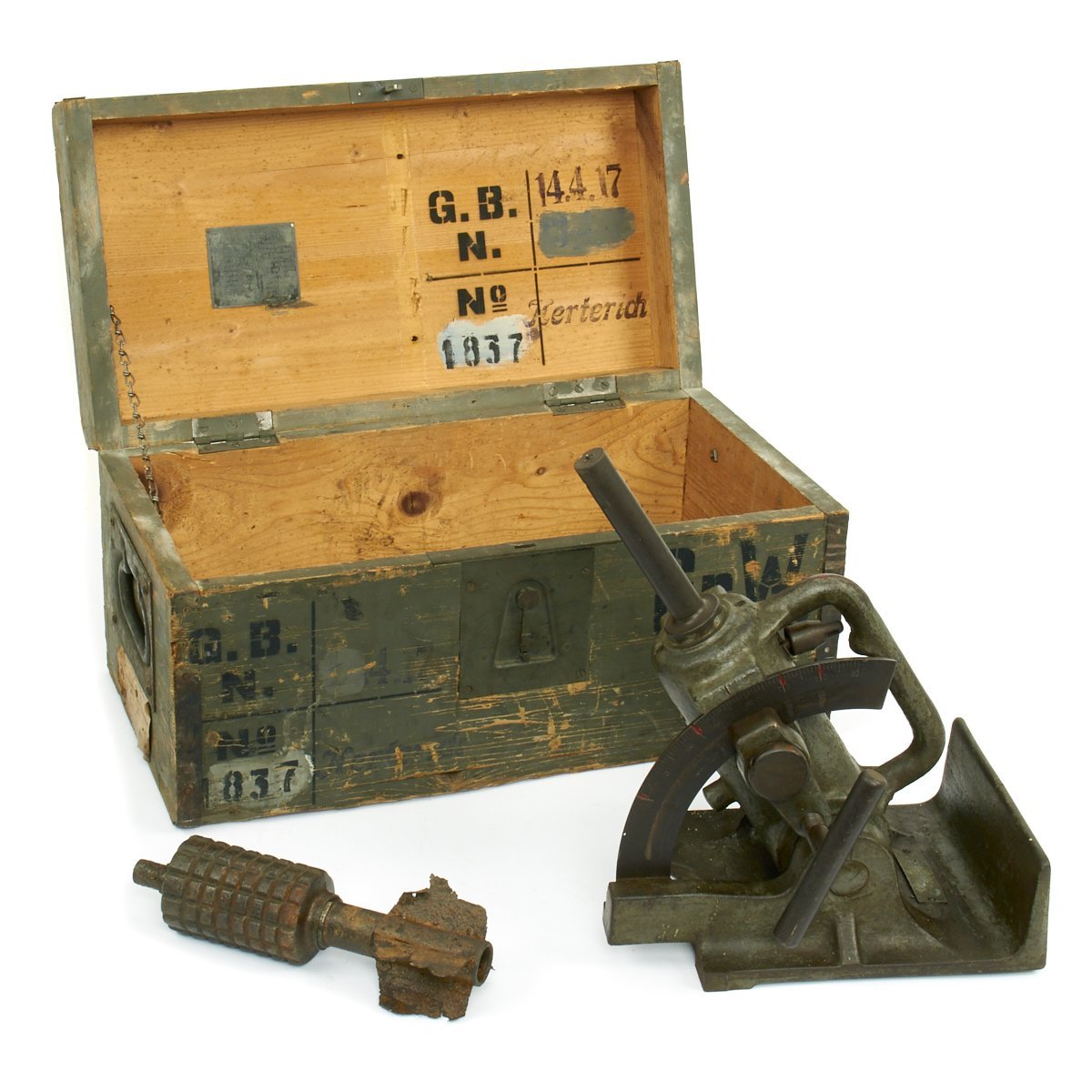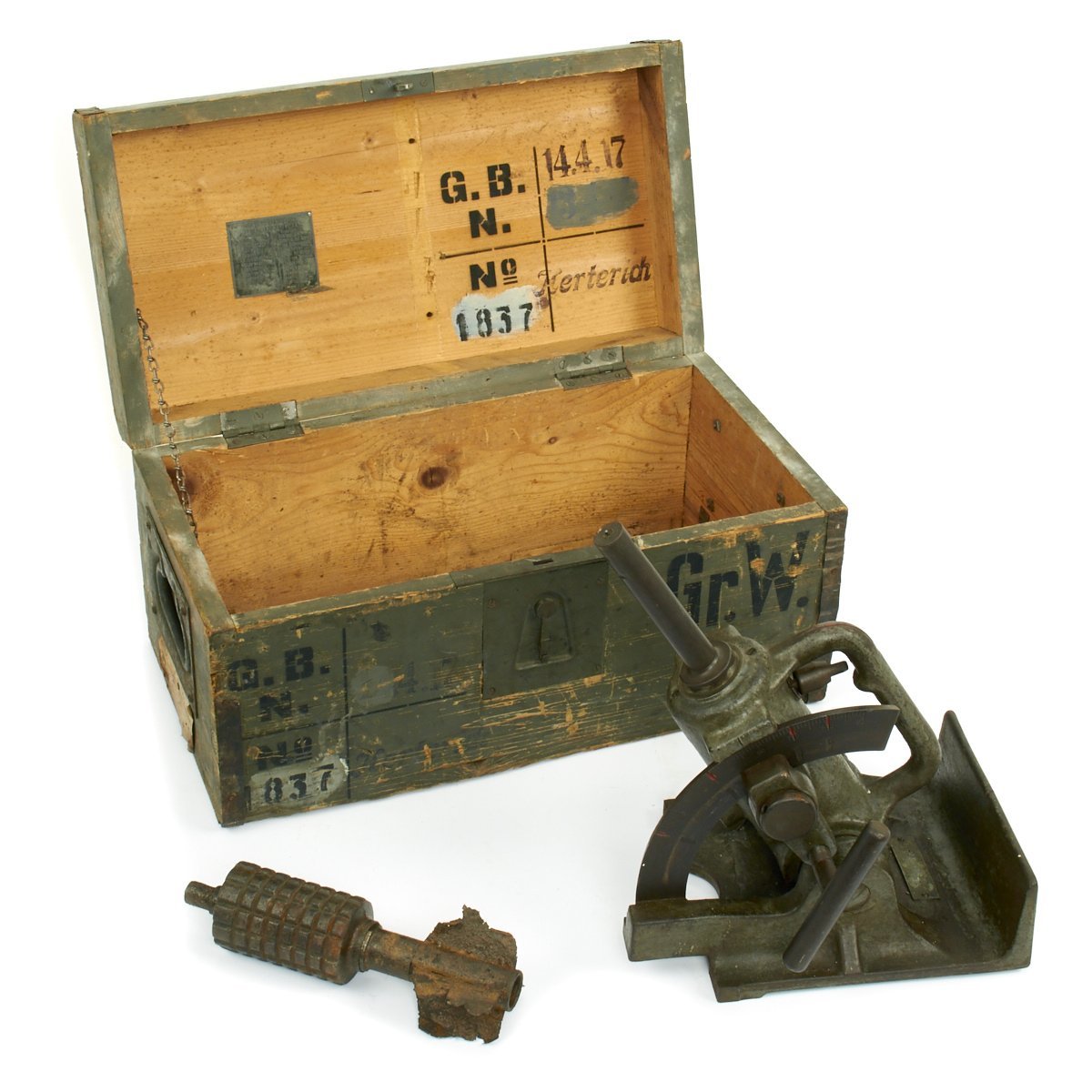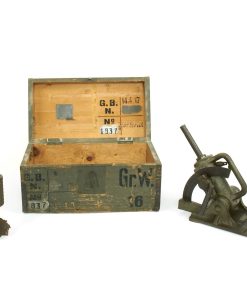Original German WWI Granatenwerfer 16 Grenade Thrower with Transit Chest – Dated 1917 Original Items
$ 6.995,00 $ 1.748,75
Original Item: Only One Available. Totally non-functional and inert having been deactivated according to specifications outlined by the BATF (Bureau of Alcohol, Tobacco, Firearms and Explosives).
This is an exceptionally rare German World War One Granatwerfer 16 contained in its matched original transit chest and complete with an inert grenade round. It is dated 14.4.17 (April 4th, 1917) and both the transit chest and launcher are marked with the same serial number.
An wonderful article by Forgotten Weapons on the Granatwerfer 16 can be found at this link.
Developed from a weapon originally designed by a priest, of all people, in the Austro-Hungarian army, the Granatenwerfer 16 was a German WWI grenade thrower which bridged the gap between hand-thrown grenades and the light minenwerfers. Throwing a small grenade with a 400g (14oz) high explosive charge to a maximum range of about 300 meters (330 yards) , the Gr.W.16 with a practiced crew could maintain a rate of fire of 4-5 rounds per minute.
The Granatenwerfer 16 was a classic example of the spigot mortar type weapon. Rather than having a hollow barrel into which the projectile fit, it had a simple rod with a firing pin built in. The grenade it fired had a hollow center shaft, which fit onto the firing rod. To fire, a gunner (a 2-man crew, in practice) would first adjust the spigot rod to the correct angle for the desired range, depress the cocking collar until the firing pin was cocked, rotate the safety lever to the “safe” position, insert a fuse into a grenade (they were fairly sensitive impact fuses), slide the grenade onto the launcher, remove the safety pin, and fire the grenade by means of a lanyard pull. The Gr.W.16 was particularly portable because of its light weight – the launcher itself weighted 31 pounds and the base plate an additional 48 pounds. Thus both parts could be easily carried across areas too confined, muddy, or otherwise impractical to drag a wheeled minenwerfer through.
The grenade itself contained a special blank rifle cartridge (actually just a standard service round with the projectile removed), which provided the energy to launch – the granatenwerfer itself simply struck the cartridge primer to fire it. The Gr.W.16s proved to be popular and very effective weapons for the Germans. They had a high rate of fire, useful range, and reasonable effective detonation. They could be used in either direct or indirect fire applications – direct fire was used to fire at things like sentry posts, gun loopholes, and the like. When fired this way, the grenade fragments would fill an area roughly 5m wide and 50m long, while a round fired in a high angle trajectory would have a bursting radius of about 30 meters. Minimum high-angle range was 50 meters, to avoid endangering the firing crew.
In terms of manufacturing, the Gr.W.16 was a very simple device, and easy to produce, with only a few moving parts and noting requiring the level of precision that a conventional barrel would need. This made it idea for production by companies like toy manufacturers, who had experience with casting relatively small parts to relatively loose tolerances.
Fast Shipping with Professional Packaging
Thanks to our longstanding association with UPS FedEx DHL, and other major international carriers, we are able to provide a range of shipping options. Our warehouse staff is expertly trained and will wrap your products according to our exact and precise specifications. Prior to shipping, your goods will be thoroughly examined and securely secured. We ship to thousands clients each day across multiple countries. This shows how we're dedicated to be the largest retailer on the internet. Warehouses and distribution centres can be located throughout Europe as well as the USA.
Note: Orders with more than one item will be assigned a processing date depending on the item.
Before shipping before shipping, we'll conduct a thorough inspection of the items you have ordered. Today, the majority of orders will be delivered within 48 hours. The delivery time will be between 3-7 days.
Returns
The stock is dynamic and we cannot completely manage it because multiple stakeholders are involved, including our factory and warehouse. So the actual stock may alter at any time. It's possible that you may not receive your order once the order has been made.
Our policy is valid for a period of 30 days. If you don't receive the product within 30 days, we are not able to issue a refund or an exchange.
You can only return an item if it is unused and in the same state as the day you received it. You must have the item in its original packaging.
Related products
Uncategorized
Uncategorized
Band of Brothers ORIGINAL GERMAN WWII Le. F.H. 18 10.5cm ARTILLERY PIECE Original Items
Uncategorized
Armored Burgonet Helmet & Polearm from Scottish Castle Leith Hall Circa 1700 Original Items
Uncategorized
Uncategorized
Uncategorized
Uncategorized
Uncategorized
Uncategorized
Uncategorized
Armoured Fighting Vehicles of the World: AFVs of World War One (Hardcover Book) New Made Items
Uncategorized
Uncategorized
Uncategorized
Australian WWII Owen MK1 Machine Carbine SMG Custom Fabricated Replica with Sling Original Items
Uncategorized
Uncategorized
Uncategorized
Angolan Rebel 1970s era 60mm Inert Display Mortar from Angolan Civil War Original Items
Uncategorized












































































